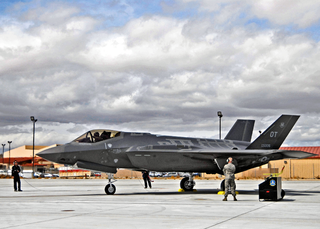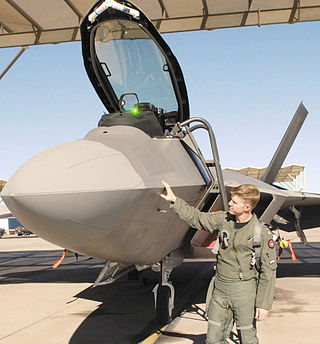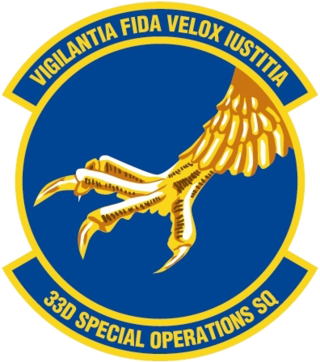
The 53rd Wing is a wing of the United States Air Force based at Eglin Air Force Base, Florida. The wing reports to the United States Air Force Warfare Center at Nellis Air Force Base, Nevada, which in turn reports to Headquarters Air Combat Command.

The 19th Fighter Squadron is a United States Air Force fighter squadron and is a part of the Pacific Air Forces' (PACAF) 15th Wing based at Joint Base Pearl Harbor–Hickam, Hawaii.

The 43rd Fighter Squadron is part of the 325th Fighter Wing at Tyndall Air Force Base, Florida. It conducts advanced fighter training for F-22 Raptor pilots.

The 54th Fighter Squadron is an inactive United States Air Force unit. Its last assignment was to the 3d Operations Group, being stationed at Elmendorf Air Force Base, Alaska. It was inactivated on 28 April 2000.

The 55th Fighter Squadron is part of the 20th Fighter Wing at Shaw Air Force Base, South Carolina. It operates the General Dynamics F-16 Fighting Falcon aircraft conducting air superiority missions.

The 60th Fighter Squadron is a United States Air Force unit that is part of the 33d Fighter Wing at Eglin Air Force Base, Florida; It is tasked with training pilots on the Lockheed Martin F-35A Lightning II.

The 61st Fighter Squadron is an active United States Air Force unit, assigned to the 56th Operations Group, at Luke Air Force Base, Arizona. It operates the F-35 Lightning II aircraft, conducting Pilot training.

The 79th Fighter Squadron is part of the 20th Fighter Wing at Shaw Air Force Base, South Carolina. It operates the General Dynamics F-16 Fighting Falcon aircraft conducting air superiority missions.

The 6th Weapons Squadron is an active United States Air Force unit. It is assigned to the USAF Weapons School, based at Nellis Air Force Base, Nevada. It was previously assigned to the Seventh Air Force, being inactivated at Yokota Airfield, Japan on 20 February 1947.

The 48th Flying Training Squadron is part of the 14th Flying Training Wing based at Columbus Air Force Base, Mississippi. It operates T-1 Jayhawk aircraft conducting flight training. The squadron is one of the oldest in the Air Force, being formed during World War I as the 48th Aero Squadron on 4 August 1917.

The 31st Combat Training Squadron is an active United States Air Force unit. It is currently assigned to the Nevada Test and Training Range at Nellis Air Force Base, Nevada.

The 59th Test and Evaluation Squadron is a United States Air Force unit. It is assigned to the Air Combat Command 53d Wing, 53d Test Management Group at Nellis Air Force Base, Nevada.

The 15th Test and Evaluation Squadron is a United States Air Force unit, stationed at Eglin Air Force Base, Florida and assigned to the 753rd Test and Evaluation Group. It was first activated in the expansion of the United States military forces prior to World War II as the 15th Pursuit Squadron. It moved to Panama in 1942, where it participated in the defense of the Panama Canal. It returned to the United States, where it was a Replacement Training Unit for fighter pilots until 1944, when it was disbanded as the 15th Fighter Squadron in a reorganization of Army Air Forces training units in 1944

The 445th Test Squadron is a United States Air Force squadron. It is assigned to the 412th Operations Group at Edwards Air Force Base, California. The 445th is part of the Air Force Test Center. Originally constituted in 1943 as the 445th Fighter Squadron, it was involved in the early testing of the first U.S. jets, the Bell P-59 Airacomet and later the Lockheed P-80 Shooting Star. The squadron would also be involved in flight-testing captured enemy aircraft, such as the Mitsubishi A6M Zero. During the Cold War, the unit served under the Air Defense Command as the 445th Fighter-Interceptor Squadron, flying various interceptor aircraft in defense of the Continental United States. De-activated in 1968 following a draw-down of active duty interceptor units, it was re-activated as the 6512th Test Squadron Squadron in 1969, beginning its official flight-testing mission. The unit was de-activated, re-activated, and re-designated multiple times over its life, being most recently re-activated with its current name in 2022.

The 28th Test and Evaluation Squadron is an active United States Air Force unit. Its current assignment is with the 53d Wing, based at Eglin Air Force Base, Florida.

The 24th Fighter Squadron is a United States Air Combat Command unit, assigned to the 495th Fighter Group at Naval Air Station Joint Reserve Base Fort Worth, Texas. The squadron was activated in 2019 and flies the F-35A as an active associate unit of the 457th Fighter Squadron.

The 53rd Test and Evaluation Group is a group of the United States Air Force. It is a part of the 53rd Wing, and is headquartered at Nellis AFB, Nevada.

The 11th Fighter-Interceptor Squadron is an inactive United States Air Force unit. Its last assignment was with the 343d Fighter Group at Duluth Airport, Minnesota, where it was inactivated on 30 June 1968.

The 33d Operations Group is the flying component of the 33d Fighter Wing, assigned to Air Education and Training Command of the United States Air Force. The group is stationed at Eglin Air Force Base, Florida.

The 33rd Special Operations Squadron is a United States Air Force unit, assigned to the 27th Special Operations Group at Cannon Air Force Base, New Mexico. The squadron operates the General Atomics MQ-9 Reaper.




























